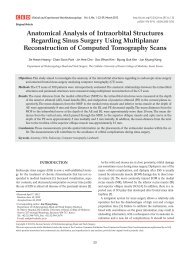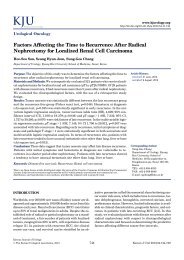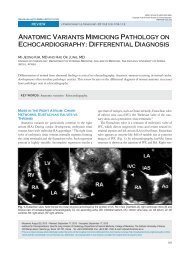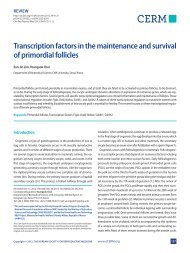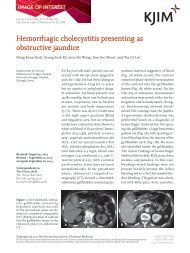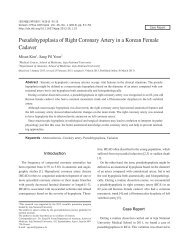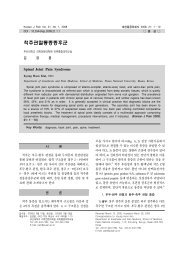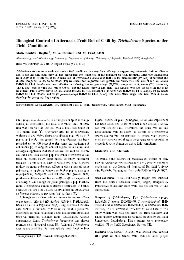Detection of Helicobacter pylori in Gastric Aspirates Using a ...
Detection of Helicobacter pylori in Gastric Aspirates Using a ...
Detection of Helicobacter pylori in Gastric Aspirates Using a ...
You also want an ePaper? Increase the reach of your titles
YUMPU automatically turns print PDFs into web optimized ePapers that Google loves.
Kim HD, et al: <strong>Helicobacter</strong> <strong>pylori</strong> <strong>in</strong> <strong>Gastric</strong> Aspirate 33<br />
Table 4. Results <strong>of</strong> the Diagnostic Tests for <strong>Helicobacter</strong> <strong>pylori</strong> Infection<br />
Based on the Urea Breath Test Results<br />
Sensitivity<br />
Specificity<br />
Positive Negative<br />
predictive predictive<br />
value value<br />
Monoclonal antibody test 78 100 100 76<br />
Rapid urease test 89 100 100 86<br />
Culture 47 100 100 57<br />
Polymerase cha<strong>in</strong> reaction 100 72 84 100<br />
Data are presented <strong>in</strong> percentage.<br />
ulcer is active or <strong>in</strong> remission, patients with low grade MALT<br />
lymphoma, and patients who have undergone resection <strong>of</strong> early<br />
gastric cancer. 9 Therefore, EGD is required for both diagnosis <strong>of</strong><br />
gastroduodenal disease and documentation <strong>of</strong> H. <strong>pylori</strong> <strong>in</strong>fection.<br />
RUT has been widely used because it is simple, cheap, and<br />
easy to carry out. 10 But, a limitation to RUT is the bacterial<br />
load necessary to obta<strong>in</strong> sufficient sensitivity. A semiquantitative<br />
evaluation <strong>of</strong> the bacteria by histology clearly showed that<br />
false-negative urease tests corresponded to the lowest histological<br />
scores for H. <strong>pylori</strong>. 11-13 Another limitation is the sampl<strong>in</strong>g<br />
from only a small part <strong>of</strong> the stomach (i.e., a few mm 2 <strong>of</strong> a total<br />
surface area <strong>of</strong> 800 cm 2 ), which can lead to possible sampl<strong>in</strong>g<br />
errors and the subsequent need to do several biopsies. 14 Another<br />
reason for a false-negative test is the presence <strong>of</strong> <strong>in</strong>test<strong>in</strong>al<br />
metaplasia, which also corresponds to an <strong>in</strong>hospitable environment<br />
for H. <strong>pylori</strong>. Dyes used dur<strong>in</strong>g chromoendoscopy, such as<br />
methylene blue, may result <strong>in</strong> false-positive RUQ, therefore, the<br />
specimens for this test must be taken before spray<strong>in</strong>g the dyes. 15<br />
RUT takes 1 to 24 hours to complete. For rout<strong>in</strong>e use, most endoscopists<br />
read RUT results earlier than recommended, which<br />
leads to a marked decrease (20%) <strong>in</strong> sensitivity. 16<br />
Among the non<strong>in</strong>vasive <strong>in</strong>direct tests, UBT has the best sensitivity<br />
<strong>of</strong> approximately 95%. 17 However, false-negative results<br />
may also occur when PPI and antibiotics are used. UBT should<br />
be performed to detect H. <strong>pylori</strong> separately after EGD <strong>in</strong> patients<br />
with gastroduodenal diseases.<br />
HpSA has the advantage <strong>of</strong> be<strong>in</strong>g a direct non<strong>in</strong>vasive test<br />
because it detects H. <strong>pylori</strong> antigens <strong>in</strong> an easily-obta<strong>in</strong>ed specimen.<br />
18,19 The monoclonal antibody-based HpSA has a high<br />
specificity and sensitivity. However, the lowest concentration<br />
could not be detected after only a 24-hour delay <strong>in</strong> experimentally<br />
spiked specimens. 20 Treatment with the mucolytic agent<br />
N-acetylcyste<strong>in</strong>e decreases both the specificity and sensitivity. 21<br />
While the test is quite specific, it is possible that rare <strong>Helicobacter</strong><br />
species present <strong>in</strong> stools may also be detected.<br />
<strong>Gastric</strong> juice represents a pooled source <strong>of</strong> events <strong>in</strong> the entire<br />
gastric microenvironment, and it may be valuable for study<strong>in</strong>g H.<br />
<strong>pylori</strong> whose mucosal distribution is patchy and variable. <strong>Gastric</strong><br />
juice allows the detection <strong>of</strong> H. <strong>pylori</strong> by culture, sta<strong>in</strong><strong>in</strong>g,<br />
urease test, and PCR because H. <strong>pylori</strong> is found <strong>in</strong> gastric juice<br />
due to the turnover <strong>of</strong> gastric mucosa. But the culture sensitivity<br />
from gastric juice is much lower. 8 In addition, the culture is<br />
laborious and requires several days. <strong>Gastric</strong> juice PCR is highly<br />
sensitive and specific. 22 However, the possibility <strong>of</strong> false positives<br />
arises when endoscopes or gr<strong>in</strong>d<strong>in</strong>g apparati <strong>in</strong> the lab are<br />
not correctly cleaned and PCR is laborious as well. 23<br />
The results <strong>of</strong> this study demonstrated that H. <strong>pylori</strong>-specific<br />
antigen <strong>in</strong> gastric juice can be detected by a monoclonal antibody-based<br />
immunochromatographic assay. The specificity <strong>of</strong><br />
the monoclonal antibody-based test was higher than PCR and<br />
the sensitivity <strong>of</strong> it was higher than culture as well. Additionally,<br />
the monoclonal antibody-based test is cheap, easy to perform,<br />
is not time-consum<strong>in</strong>g when compared with culture and<br />
PCR. Although the sensitivity <strong>of</strong> monoclonal antibody-based<br />
test <strong>in</strong> this study was marg<strong>in</strong>ally lower than RUT, the specificity<br />
was the same. In addition, it did not require biopsy and posed<br />
no risk <strong>of</strong> serious biopsy-related complications such as bleed<strong>in</strong>g.<br />
In conclusion, RUT may not be able to detect the presence <strong>of</strong> H.<br />
<strong>pylori</strong> due to false negative, whereas gastric juice, be<strong>in</strong>g a more<br />
global sample, may overcome this limitation because gastric<br />
juice reflects the actual microenvironment and the global level<br />
<strong>of</strong> <strong>in</strong>fection <strong>in</strong> the stomach. Monoclonal antibody-based test<br />
from gastric aspirate may be useful for H. <strong>pylori</strong> detection as an<br />
additive test. This is the first study to detect H. <strong>pylori</strong> by monoclonal<br />
antibody-based test <strong>in</strong> gastric aspirate. Further studies are<br />
warranted to clarify the role <strong>of</strong> monoclonal antibody-based test<br />
<strong>in</strong> gastric aspirate.<br />
CONFLICTS OF INTEREST<br />
No potential conflict <strong>of</strong> <strong>in</strong>terest relevant to this article was<br />
reported.<br />
REFERENCES<br />
1. Goodw<strong>in</strong> CS, Mendall MM, Northfield TC. <strong>Helicobacter</strong> <strong>pylori</strong> <strong>in</strong>fection.<br />
Lancet 1997;349:265-269.<br />
2. Correa P, Piazuelo MB. Evolutionary history <strong>of</strong> the <strong>Helicobacter</strong><br />
<strong>pylori</strong> genome: implications for gastric carc<strong>in</strong>ogenesis. Gut Liver<br />
2012;6:21-28.<br />
3. Blaser MJ. Ecology <strong>of</strong> <strong>Helicobacter</strong> <strong>pylori</strong> <strong>in</strong> the human stomach.<br />
J Cl<strong>in</strong> Invest 1997;100:759-762.<br />
4. Suzuki H, Saito Y, Hibi T. <strong>Helicobacter</strong> <strong>pylori</strong> and gastric mucosaassociated<br />
lymphoid tissue (MALT) lymphoma: updated review<br />
<strong>of</strong> cl<strong>in</strong>ical outcomes and the molecular pathogenesis. Gut Liver<br />
2009;3:81-87.<br />
5. Rautel<strong>in</strong> H, Lehours P, Mégraud F. Diagnosis <strong>of</strong> <strong>Helicobacter</strong> <strong>pylori</strong><br />
<strong>in</strong>fection. <strong>Helicobacter</strong> 2003;8 Suppl 1:13-20.<br />
6. Mégraud F, Lehours P. <strong>Helicobacter</strong> <strong>pylori</strong> detection and antimicrobial<br />
susceptibility test<strong>in</strong>g. Cl<strong>in</strong> Microbiol Rev 2007;20:280-322.<br />
7. Tsuchiya M, Imamura L, Park JB, Kobashi K. <strong>Helicobacter</strong> <strong>pylori</strong>



